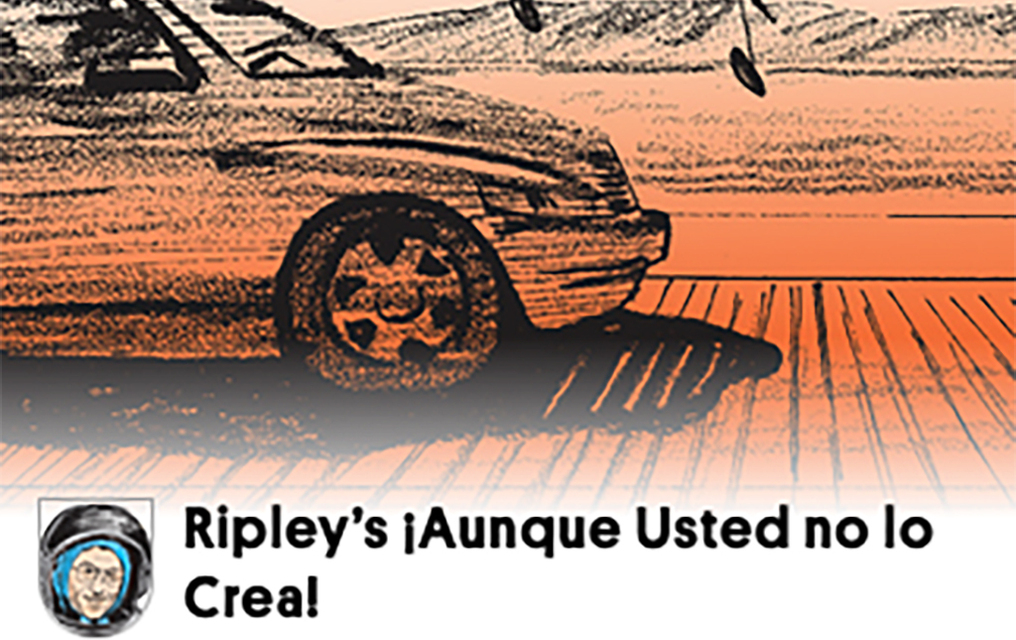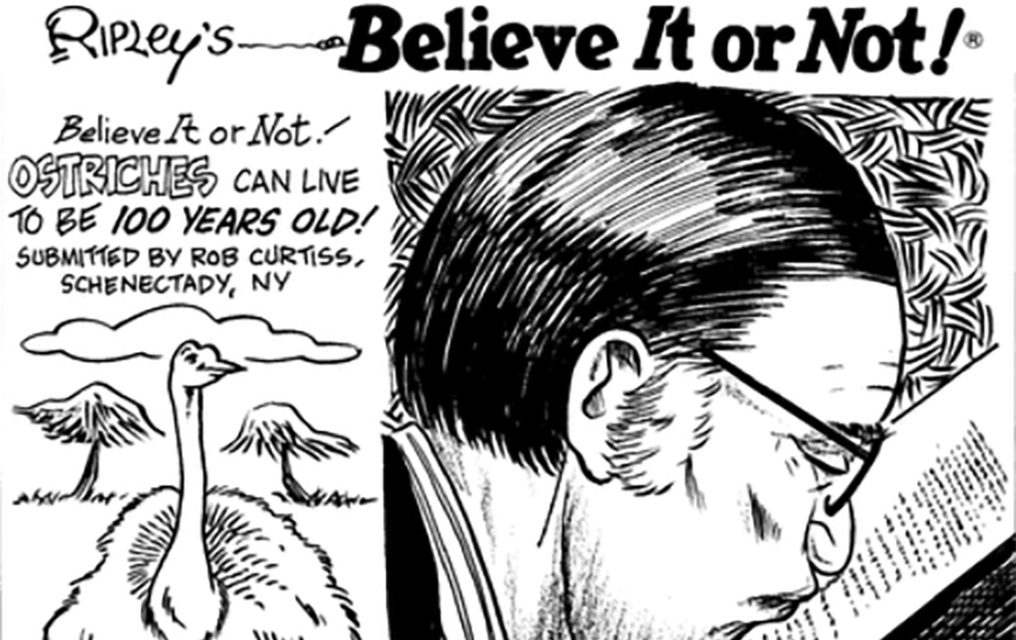Ripley's Believe It or Not by Ripley’s Believe It or Not! for June 15, 2012
Transcript:
In 1862, the first rapid fire gun to be used in combat picked up the nickname the Coffee Mill Gun in the way it was hand cranked! Indigenous peoples of Paraguay account for only about 5% of the population, but their Guarani language is spoken by about 90% of its people, making Paraguay the only country in the Americas where an indigenous languages spoken by a majority! The Maasai warriors of Kenya have a cricket team that serves as role models and ambassadors for their people!






jploch5408 over 12 years ago
In the film “The Outlaw Josey Wales,” there’s a scene where Clint Eastwood is gunning down Union soldiers with a hand-cranked weapon. Possibly a Gatling gun?
bbwoof over 12 years ago
I’ve learned things about the civil war that I either didn’t know or had forgotten or both from reading this section. Thanks for the history lesson refresher.
Mr. Majestyk over 12 years ago
The Gatling gun was first used in warfare during the American Civil War. The gun was not accepted by the Union Army until 1866, but a “sales engineer” of the manufacturing company demonstrated it in combat The Gatling gun saw only limited use in the Civil War, (Ben Butler used two around Petersburg and eight on gunboats; Porter acquired one; and Hancock ordered twelve for his I (Veteran) Corps), however, the conflict did test this weapon, perhaps the first successful true machine gun used in warfare. Invented by Dr. Richard Jordan Gatling, the Civil War model served as the precursor of more successful models. The Gatling gun was a hand-crank-operated weapon with 6 barrels revolving around a central shaft. The cartridges were fed to the gun by gravity through a hopper mounted on the top of the gun. 6 cam-operated bolts alternately wedged, fired, and dropped the bullets, which were contained in steel chambers. Gatling used the 6 barrels to partially cool the gun during firing. Since the gun was capable of firing 600 rounds a minute, each barrel fired 100 rounds per minute. The gun had a number of problems, however. The bores were tapered, and often the barrels and chambers did not exactly align, affecting accuracy and velocity. The chamber system itself, in which a paper cartridge was contained inside a capped steel chamber, was both expensive and fragile. While the gun showed much promise and fired the standard .58-caliber ammunition, it had so many drawbacks and was so radical in both design and purpose that Gatling was unable to interest the U.S. government. The army purchased none of his guns, but Maj. Gen. Benjamin F. Butler, after a field test, purchased 12 for $1,000 each and two were used on the Petersburg front in 1864 and apparently were considered successful. In Jan. 1865 Gatling’s improved Model 1865 gun was tested by the Ordnance Department. Among other things, this weapon used rimfire copper-cased cartridges instead of the steel-chambered paper variety. Though this model did not see service, it was adopted officially in 1866. Having at last received government approval, Gatling began to sell his guns throughout the world; they achieved lasting fame in the post-war years. Due to it’s late introduction, and many technical problems, the gun had little or no effect on the outcome of the war.
Mr. Majestyk over 12 years ago
The Agar or “Coffee Mill” gun..In 1861, the Agar machine gun was demonstrated to President Abraham Lincoln, who was so impressed that he ordered all ten available weapons to be purchased immediately, at a cost of $1,300 each, which was a very high price at the time. Later in the same year, General McClellan ordered an additional fifty weapons, at a reduced cost of $735 each. In 1861, General Butler purchased two guns at $1,300 each, and in the following year General Fremont also purchased two guns, paying $1,500 for each.
The guns were condemned by the Ordnance Department for using too much ammunition to ever be practical, and the guns saw little use on the battlefield. They were often deployed to remote locations to guard bridges and narrow passes.5 The guns often performed poorly in the field. The single barrel design proved vulnerable to overheating, and the weapon was also prone to jamming. The special steel tubes used to hold the cartridges were heavy and expensive, and were often prone to loss. Later cartridges would use brass, but this was not widely available during the time that the Agar machine gun was used. The gun’s range was also criticized. It had a range of about 800 yards, which was roughly the same as the range of the rifle-muskets used by infantry. A longer range weapon would have been preferred.
Because of the way it was used in battle, the Agar machine gun, like most machine guns of the period, was never able to show its potential. Machine guns would later become much more important on the battlefield. In 1865, the few remaining Agar machine guns were sold for $500 each.
Puddleglum2 over 12 years ago
Keeping that hand-cranked Rapid-Fire gun going was a tough grind!
Mr. Majestyk over 12 years ago
I have a Class 3 FFL and special Federal Permits to use and manufacture explosives. I also have almost 40 years experience of working with all types of weapons. The information is available on the internet as well as history books on antique weapons. I wasn’t aware that a source was required in comic strip comments. I don’t see one in any of yours.
Mr. Majestyk over 12 years ago
You said that I should acknowledge my source and I just replied, regardless of your interest.
gocomicsmember over 12 years ago
gmartin997 is entitled to not be interested. I found the information about the different machine guns of the period very enlightening. Thank you. He did make a valid point, however. If you copied the info verbatim from another source, it would have been standard procedure to have said so. Copyrighted material definitely needs to be acknowledged, and even when a copyright does not exist, common courtesy demands proper recognition.
Dberrymanal1 over 12 years ago
Then why did the Emancipation Proclamation not apply to Gen. Grant’s slaves? Or any slaves inside the Union? Gen. Grant said "if I thought this war was about freeing slaves I would resign my commission and offer my sword to the other side! Gen Robert E. Lee on the other hand hated slavery and freed the ones who were left to him in his father’s will.
Sandy Shore over 12 years ago
I like my “Ripley’s Believe It Or Not” like I like my men: unbelievable & full of trivia about cricket.